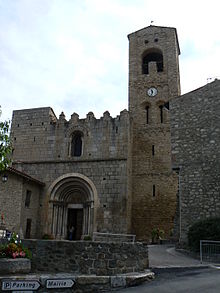History
Mentioned for the first time in 1018, the church, owned by the bishops of Elne, was acquired by count Wilfred II of Cerdanya, who made their capital in the town, in 1025. In 1094 count William I ordered the construction of a monastery here, which was founded in 1097 and entrusted to the Augustinians.
Until 1167, the priory acquired numerous privileges and possessions, including castles and villages. In 1356 King Peter III of Aragon ceded to the monks the old palace of the counts.
In the 14th century the church was fortified with a line of walls featuring pyramidal merlons. The priory continued to increase in importance until its secularization in 1592. After the French Revolution in 1789 it was repeatedly modified.
Architecture
The church, in Romanesque style, has a façade in pink marble, surmounted by a tympanum decorated by a Madonna enthroned with Child and Angels. The columns supporting the archivolts have capitals with rampaging lions, palms and sheep.
The circular apse features exteriorly Lombard bands and a sawtooth-shaped frieze, as well as three windows with archivolts over small columns.
The interior is on a nave and two aisles. It houses a retablo by Jaume Cascalls (1345). The bell tower is in Lombard Romanesque style; it has Lombard bands decorating each of the three storey, the middle one having two windows and the upper one a large arch.

Romanesque architecture is an architectural style of medieval Europe characterized by semi-circular arches. There is no consensus for the beginning date of the Romanesque style, with proposals ranging from the 6th to the 11th century, this later date being the most commonly held. In the 12th century it developed into the Gothic style, marked by pointed arches. Examples of Romanesque architecture can be found across the continent, making it the first pan-European architectural style since Imperial Roman architecture. The Romanesque style in England is traditionally referred to as Norman architecture.

The Basilica of Sant'Ambrogio is a church in the centre of Milan, northern Italy.
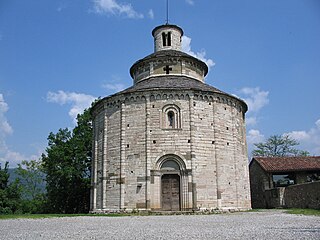
The Rotonda di San Tomè is a church in the comune of Almenno San Bartolomeo, in the province of Bergamo, Lombardy, Northern Italy.
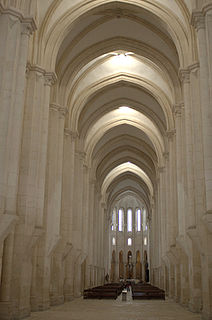
Portuguese Gothic architecture is the architectural style prevalent in Portugal in the Late Middle Ages. As in other parts of Europe, Gothic style slowly replaced Romanesque architecture in the period between the late 12th and the 13th century. Between the late 15th and early 16th century, Gothic was replaced by Renaissance architecture through an intermediate style called Manueline.

Nostra Signora di Tergu is a parish church in Tergu, province of Sassari, Sardinia, Italy. One of the most outstanding examples of Romanesque architecture in the island, the church and the remains of the annexed abbey are located in a countryside area outside the village.
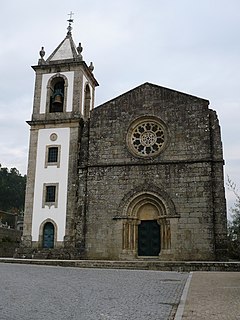
The Church of Fontarcada or Matriz de Fontarcada was a Romanesque monastic church to a Benedictine monastery founded in 1067, now the parish church of Fontarcada. It was classified as a National Monument by decree on 16 June 1910. It is dedicated to Saint Saviour.

Serrabone Priory is a former monastery of Canons Regular in the commune of Boule-d'Amont, in Pyrénées-Orientales. The priory is located in a wild and beautiful area in the valley of the Boulès in the heart of an oak forest, at the centre of the Aspres mountain range on the eastern foothills of the Canigou, about 30 km from Perpignan.

Church of San Pedro de Plecín is a former Roman Catholic church located in Alles, capital of the council of Peñamellera Alta in Asturias, Spain.

The Monastery of Santa Maria de Vallbona is a Cistercian abbey in Vallbona de les Monges, in the comarca of Urgell, Catalonia, Spain. Founded in the early 12th century, it is one of the most important monasteries in Catalonia; its church represents an example of transition between Romanesque and Gothic architecture. The abbey was declared a national monument in 1931.

The Cathedral of Tarragona is a Roman Catholic church in Tarragona, Catalonia, Spain. The edifice is located in a site previously occupied by a Roman temple dating to the time of Tiberius, a Visigothic cathedral, and a Moorish mosque. It was declared a national monument in 1905.

Sant Pere de Galligants is Benedictine abbey in Girona, Catalonia. Since 1857, it is home to the Archaeology Museum of Catalonia venue in the city. The name translates to English as "Saint Peter of Galligants", where Galligants refers to the River Galligants that runs past the abby.

The Royal Abbey of Santa María de Alaón is a former Benedictine abbey, earlier a Cluniac priory, in Sopeira in the Pyrenean county of Ribagorza, Aragon, Spain, established in the late 11th or early 12th century over a 6th or 7th century foundation. The monastery is notable for its Lombard Romanesque architectural style.

The Basilica di Sant'Andrea is the church of a monastery in Vercelli, Piedmont, northern Italy, founded in 1219 by Cardinal Guala Bicchieri and completed in 1227. It represents an early example of Gothic architecture in Italy, inspired by Cistercian models and featuring Romanesque elements as well.

Sant Llorenç de Morunys is a Benedictine monastery in Sant Llorenç de Morunys Province of Lleida, Catalonia, Spain. Built in the 11th century in Romanesque style, it was declared a Bien de Interés Cultural landmark in 1976.

Sant Pere de Casserres is a Benedictine monastery in the town of Les Masies de Roda, Osona comarca, Catalonia, Spain. The 11th-century Romanesque-style building was declared a Bien de Interés Cultural landmark in 1931.

Santa Maria d'Amer is a Benedictine monastery in Amer, Selva, Catalonia, Spain.
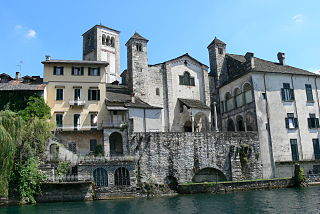
The Basilica di San Giulio is a Roman Catholic church on the small Isola San Giulio in the center of Lake Orta, province of Novara, north-western Italy. It has the status of a minor basilica. Although the island is part of the Orta San Giulio municipality, the basilica belongs to the San Giacomo parish, including the island and a portion of the west coast of the lake in San Maurizio d'Opaglio municipality.

The Romanesque style of architecture was introduced in Portugal between the end of the 11th and the beginning of the 12th century. In general, Portuguese cathedrals have a heavy, fortress-like appearance, with crenellations and few decorative elements apart from portals and windows. Portuguese Romanesque cathedrals were later extensively modified, among others the Old Cathedral of Coimbra, although it only had some minor changes.

The Church of San Lorenzo is located in Vallejo de Mena, a village in the Valley of Mena, part of the region of Las Merindades in the Province of Burgos, Spain.
